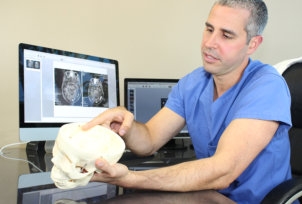Spine surgery, part 1 - First steps

Unfortunately, life is not always cheerful and enjoyable; sometimes people become ill. It is good, if the illness resolves rapidly as a common cold, and never comes back. But sometimes pain stays for a week, month, or more, and nothing seems to help. Painkillers, injections, all other medications seem to be worthless.
Perhaps, that's the moment when you should think about MRI. Your doctor can advise you about getting an MRI. Or your neighbor, who had the same problem several years ago, will try to give you advice or tell you about his close friend N., who in turn had the same problem and ended up having surgery...
 herniated disc So, you've got MRI and heard your diagnosis: herniated disc. MRI doctor refers you to a neurosurgeon for the advice. And here begins the difficult search for the solution – what to do?!
herniated disc So, you've got MRI and heard your diagnosis: herniated disc. MRI doctor refers you to a neurosurgeon for the advice. And here begins the difficult search for the solution – what to do?!Neurosurgeons say in one voice – surgery! (that's what they usually do). Neurologists recommend against surgery and talk about new drugs and injections that could help, and surgery as the last option. And your experienced neighbor also gives his advice.
Search on the internet provides you with a new hope – "herniation treatment without surgery!'' That's attractive, you think. But, unfortunately, such treatment is provided only in private clinics, and it costs a lot without any guarantees of the effect.
But how to make a correct decision? Whom to trust with your health? Which clinic to choose?
Unfortunately, we cannot give a universal answer to this question, because we propose an individual solution for each patient, depending on different factors, such as age, concomitant diseases, MRI results. Our mission is to provide surgical treatment for our patients according to the best standards.
.
 |
 |
 |
|
Microscope Moller-Wedel
Hi-R 900 Halogen light |
Microscope Moller-Wedel 20-1000 Xenon light |
HAAG-STREIT microscope HS 5-1000 LED light |
In the last 20 years there was a revolution in the spine surgery – now surgeon can actually SEE what he operates. The surgical microscope was significantly improved, equipped with the light – first halogen light
150 W, then Xenon 300 W, now LED light 400 W. With x20 magnification and this light surgeon confidently distinguishes nerve roots, vessels and gently removes disc herniation with microsurgical instruments. Now surgeon can also LOOK THROUGH THE PATIENT – with the help of portable X-ray scanner, which makes it possible to glance into the body, without additional incisions. New navigation and robotic stations supplement and extend these possibilities. Therefore modern spine surgery is completely different from what was made just 20 years ago.
 |
 |
|
BODYTOM – portable scanner for intraoperative CT
and the data preparation for the robot |
Mazor Renaissance – surgical robot, facilitates implant positioning without big incisions.. |
Also, we see our mission in helping each patient to make the correct decision – to do surgery or to find another treatment.
The fundamental rule before decision making - full-scale medical examination. We ask our patients to do MRI, CT, X-ray, bone scan, densimetry, electromyography, to analyze the results of all these tests and to decide together with the patient: should we do surgery right now? Or in 2-3 weeks. Or in 6 months. Or perhaps to refuse from surgery, despite diagnosed spine lesions. Because surgery will not solve all problems, and the worn organism could not maintain stress from the anesthesia and operation, leading to new potential health issues.
We advise consulting with neurosurgeon after you've done MRI and before you decide on surgery. Perhaps, you would like to get a second opinion from another neurosurgeon to make the correct decision. Or even a third opinion. We advise you to follow recommendations from the doctor which gives you the most logical and justified answer. By the way, neurosurgeons find indications to surgery only in 10% of the referred patients. And the rest 90% continue the medical treatment prescribed by neurologists – they have no indications to the operation.



